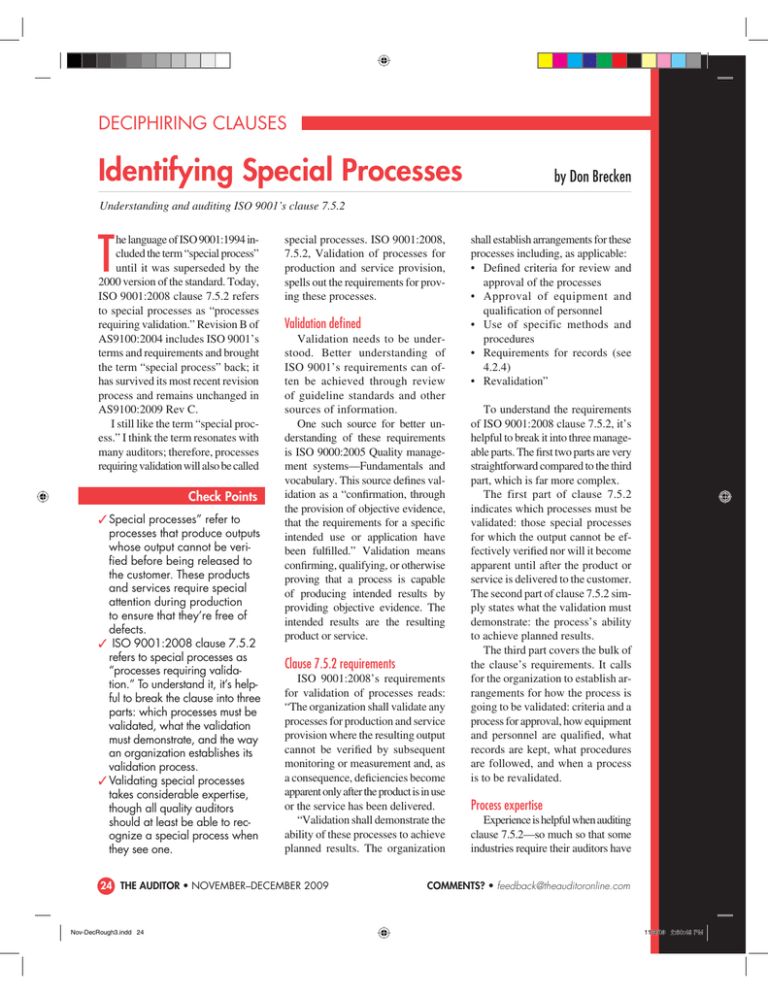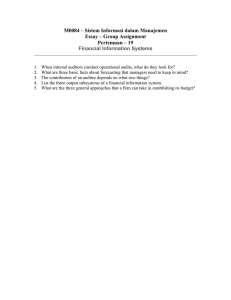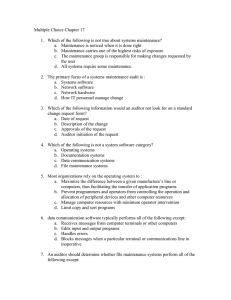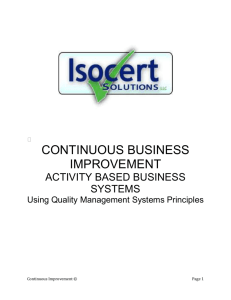T Identifying Special Processes by Don Brecken
advertisement

DECIPHIRING CLAUSES Identifying Special Processes by Don Brecken Understanding and auditing ISO 9001’s clause 7.5.2 T he language of ISO 9001:1994 included the term “special process” until it was superseded by the 2000 version of the standard. Today, ISO 9001:2008 clause 7.5.2 refers to special processes as “processes requiring validation.” Revision B of AS9100:2004 includes ISO 9001’s terms and requirements and brought the term “special process” back; it has survived its most recent revision process and remains unchanged in AS9100:2009 Rev C. I still like the term “special process.” I think the term resonates with many auditors; therefore, processes requiring validation will also be called Check Points Special processes” refer to processes that produce outputs whose output cannot be verified before being released to the customer. These products and services require special attention during production to ensure that they’re free of defects. ISO 9001:2008 clause 7.5.2 refers to special processes as “processes requiring validation.” To understand it, it’s helpful to break the clause into three parts: which processes must be validated, what the validation must demonstrate, and the way an organization establishes its validation process. Validating special processes takes considerable expertise, though all quality auditors should at least be able to recognize a special process when they see one. special processes. ISO 9001:2008, 7.5.2, Validation of processes for production and service provision, spells out the requirements for proving these processes. Validation defined Validation needs to be understood. Better understanding of ISO 9001’s requirements can often be achieved through review of guideline standards and other sources of information. One such source for better understanding of these requirements is ISO 9000:2005 Quality management systems—Fundamentals and vocabulary. This source defines validation as a “confirmation, through the provision of objective evidence, that the requirements for a specific intended use or application have been fulfilled.” Validation means confirming, qualifying, or otherwise proving that a process is capable of producing intended results by providing objective evidence. The intended results are the resulting product or service. Clause 7.5.2 requirements ISO 9001:2008’s requirements for validation of processes reads: “The organization shall validate any processes for production and service provision where the resulting output cannot be verified by subsequent monitoring or measurement and, as a consequence, deficiencies become apparent only after the product is in use or the service has been delivered. “Validation shall demonstrate the ability of these processes to achieve planned results. The organization 24 THE AUDITOR • NOVEMBER–DECEMBER 2009 Nov-DecRough3.indd 24 shall establish arrangements for these processes including, as applicable: • Defined criteria for review and approval of the processes • Approval of equipment and qualification of personnel • Use of specific methods and procedures • Requirements for records (see 4.2.4) • Revalidation” To understand the requirements of ISO 9001:2008 clause 7.5.2, it’s helpful to break it into three manageable parts. The first two parts are very straightforward compared to the third part, which is far more complex. The first part of clause 7.5.2 indicates which processes must be validated: those special processes for which the output cannot be effectively verified nor will it become apparent until after the product or service is delivered to the customer. The second part of clause 7.5.2 simply states what the validation must demonstrate: the process’s ability to achieve planned results. The third part covers the bulk of the clause’s requirements. It calls for the organization to establish arrangements for how the process is going to be validated: criteria and a process for approval, how equipment and personnel are qualified, what records are kept, what procedures are followed, and when a process is to be revalidated. Process expertise Experience is helpful when auditing clause 7.5.2—so much so that some industries require their auditors have COMMENTS? • feedback@theauditoronline.com 11/9/09 2:30:48 PM DECIPHIRING CLAUSES advanced expertise in the discipline they audit. I see this in the automotive industry, in which years of automotive experience is required before an auditor can audit for an automotive organization. It’s most obvious in the aerospace industry, in which there exists an industry-managed program for special processes called Nadcap (formerly called the National Aerospace and Defense Contractors Accreditation Program, or NADCAP). Nadcap auditors are required to be experts in the particular processes they audit. Advanced expertise may be necessary in some cases; however, skilled quality auditors should be able to navigate their way through most audit situations where ISO 9001:2008’s clause 7.5.2 applies. Be objective and expect compliance it’s imperative that an organization What must we look for as audiwith a paint process proves that the tors? Auditors must process is capable of look for compliance to producing product that Generally, if requirements. If you you cannot look meets required specificannot look at a finished cations for the painted at the output of surface. product or service and tell whether it meets a process (the Tip for auditors required specifications, The organization, then you must look at resulting product having had to estabthe process. or service) and lish arrangements for Take a paint process, know whether validation of its special for instance. The resultit conforms to processes, should be able ing output—painted p a r t s — c a n n o t b e specifications, the to produce evidence that demonstrates its procompletely verified by process is likely cesses’ ability to achieve subsequent inspection. Some characteristics a special process planned results. In other words, there should be of a painted surface, that requires records. These records such as color, gloss, dry should be collected by film thickness, and the validation. the auditor as objective Know one when you see one absence of visual paint evidence that a process was valiAuditors must be able to recognize defects, can be immediately detected dated. a special process when they see one. at the end of the paint process. HowWhen the auditor has this record Generally, if you cannot look at the ever, nobody can look at a painted in hand, he or she can compare the output of a process (the resulting surface and see that it satisfies the validation records to the current proproduct or service) and know whether corrosion resistance and adhesive cess parameters. An auditor should it conforms to specifications, the qualities specified for painted surexpect to find special processes process is likely a special process faces. Paint defects related to poor operating to the conditions under that requires validation. paint adhesion and corrosion resiswhich the process was qualified. Some typical special tance become apparent In our paint shop example, if the processes found in manuIf you cannot only after the product paint process was validated while facturing include welding, is in use. Only after look at a the paint conveyor was operating at painting, plating, and heat the product has been 20 feet per minute, for instance, then treating. Some not-so- finished product in use will we know if 20 feet per minute is the speed the obvious special processes the painted surface will or service and auditor should expect to find when may include mold making chip or rust. tell whether it observing the process. and wire crimping. ExThat said, waiting until amples of service-related after the product is in meets required Revalidation special processes include use by the customer specifications, Special processes must be revalitraining services, hotel to know whether it dated when changes are made which check-in and check-out, conforms to required then you must affect those processes’ parameters dental work, cleaning serspecifications doesn’t look at the for product or service quality. If the vices, computer help desk, make sense. To know process. auditor finds the paint shop conveyor and many food services, for sure, you must subin the above example operating at to name a few. These are ject the painted surface 23 feet per minute, ask to see where all products and services for which to a barrage of environmental tests the process was revalidated at the deficiencies become apparent only that are time consuming, costly, new line speed. after delivery to the customer. and destructive. For these reasons COMMENTS? • feedback@theauditoronline.com Nov-DecRough3.indd 25 THE AUDITOR • NOVEMBER–DECEMBER 2009 25 11/9/09 2:30:49 PM ARTICLE The skilled auditor can query the owner of any particular process about continuous improvement while auditing special processes and learn much. A paint supervisor once told me about the many ways his organization improved since my last visit. He told me how he lowered the oven temperatures by 20 degrees, increased the paint conveyor speed by two feet per minute, and that he now purchases more cost-effective pretreatment chemicals from a new supplier. He told me of the many thousands of dollars saved annually from these improvements. He was excited about sharing these achievements until I asked if he revalidated the process after making the changes. He admitted he had not. My next question was how he knew this “new” paint process was producing product to required specifications. Fortunately for him and his organization, when the process was finally revalidated the painted DECIPHIRING CLAUSES product did meet specifications, which avoided the organization having to spend many more thousands of dollars to field test and possibly recall the product. Conclusion As previously mentioned, skilled quality auditors should be able to navigate through most audit situations where ISO 9001:2008’s clause 7.5.2 applies. A skilled auditor should understand how critical it is for organizations to validate processes for production or service provision where the resulting output cannot be verified by subsequent inspection. The auditor must be objective, expect compliance, and be on the lookout for those pesky processes that require validation: special processes. About the author Don Brecken is the director of quality for Commercial Tool & Die Inc. His background includes quality leadership, management consulting, registration and surveillance audits, and quality system implementation. Brecken is a fellow of the American Society for Quality (ASQ), a certified manager of quality and organizational excellence, an RABQSA business improvement auditor, and has served on the board of examiners for the Malcolm Baldrige National Quality Award. He is also a deputy regional director for ASQ’s region 10. Brecken earned his MBA in strategic management from Davenport University’s Sneden Graduate School. He also has three undergraduate degrees in business with a technical specialty in quality leadership. Brecken instructs a variety of quality and management-related courses for Ferris State University and Davenport University’s undergraduate and A graduate programs. Righting the Audit Report (Continued from page 23) checks were implemented. A review of the electronic document management system revealed the development of an “un-publish” folder so that obsolete and expired documents can be removed from viewer access. No other expired documents were identified in the electronic document management system. The second quarter quality summary report now provides measurement evidence to indicate that a system has been developed to record on-site carrier nonconformances as a preventive measure before the external customer complains. v Post the audit summary report and observations so that everyone in the facility can review it in more detail. Remember that the audit isn’t complete until the paperwork is finished, so make this a part of the process. The auditee might have questions about specific observations in the audit report, so posting it into an electronic document management system or a protected folder that’s available to users with read-only access makes the audit results easily retrievable to both auditor and auditee. Although the audit work papers are available for records retention, 26 THE AUDITOR • NOVEMBER–DECEMBER 2009 Nov-DecRough3.indd 26 the auditor can easily refer to the posted copy to help jog his or her memory and more quickly provide answers to the auditee. The posted audit report also assists users as they work on necessary corrective and preventive actions. About the author Gayle Norman, BASF quality systems team leader and Geismar site quality management representative, is responsible for the internal audit process at its Geismar, Louisiana facility. She leads a team of 23 internal auditors from the site, four of whom are quality specialists trained as lead A auditors. COMMENTS? • feedback@theauditoronline.com 11/9/09 2:30:50 PM





